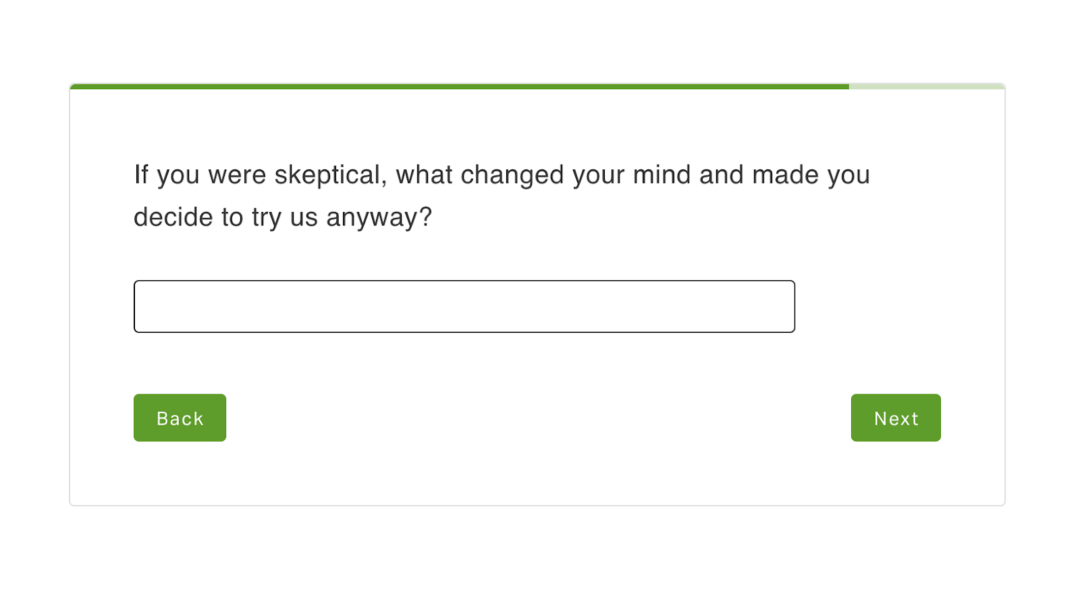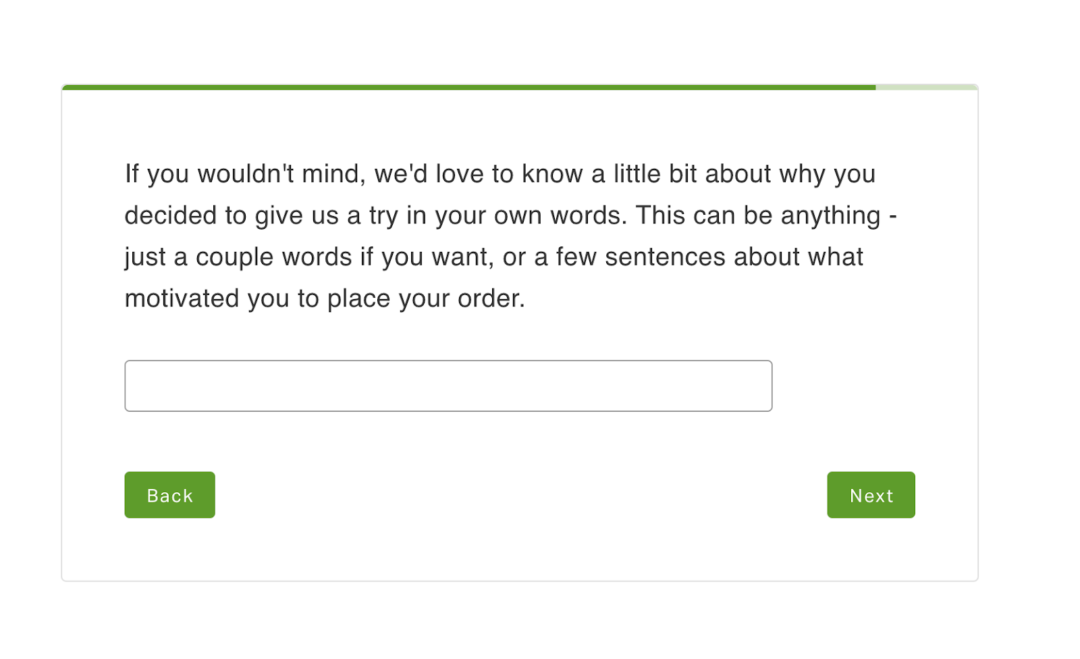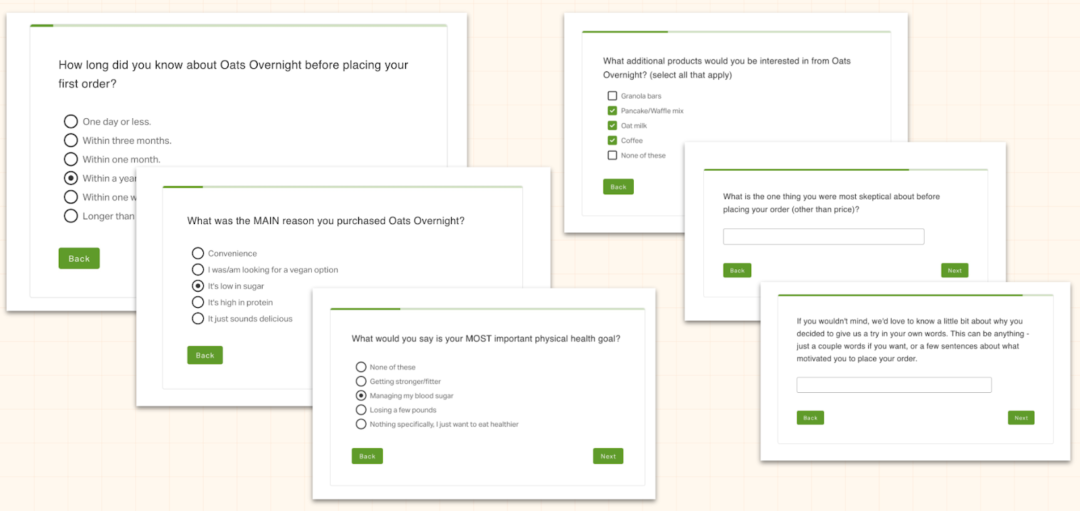
Understanding your customers is key—and nobody knows their thoughts, feelings, and opinions better than they do. Making assumptions based on their behaviors is a good start, but it’ll only get you so far.
To uncover even more insight, introduce open-ended questions into your customer surveys. Respondents answer these types of questions in their own words, without limitations, providing some of the most interesting and valuable information an ecommerce brand can gather.
In this post, we’ll cover the difference between close-ended and open-ended questions, identify when to use each, provide 50 open-ended question examples, and give top tips on crafting them for yourself.
What is an open-ended question?
Open-ended questions cannot be answered with simple ‘yes’ or ‘no’ or one-word responses. They require respondents to elaborate, drawing on their knowledge, feelings, and thoughts.
Rather than restricting responses, open-ended questions invite deeper engagement and often start with “why,” “how,” or “what” to encourage detailed answers.
These questions can also be specific or broad, depending on the type of answer you’re looking for. Typically, there are two kinds of open-ended questions:
- Specific Questions: Focused inquiries asking for a specific detail. For instance, if someone mentions discovering your brand on a podcast, you might ask which podcast. Specific open-ended questions are easy to ask, answer, and analyze, providing focused data.
- Broad Questions: Vague inquiries that seek perceptions or feelings, often requiring respondents to write a paragraph. These yield varied responses and often need sentiment analysis, making them more complex to dissect. Determine the type of data you need. Are you looking for facts or thoughts and feelings? Start there and choose the appropriate open-ended question type.


Why ask open-ended questions in your post-purchase survey?
Open-ended questions capture detailed responses that inform future decisions. Businesses should ask these questions to understand customer needs, wants, and expectations.
Key benefits of open-ended questions include:
-
- Product insights: learn which products to create next or how to update existing ones to meet customer expectations better.
- Customer journey pain points: remove friction in the buying journey by uncovering issues in the website experience, such as outdated information or broken buttons.
- Improved brand messaging: understand the most valuable aspects of your brand from the customer’s perspective, allowing you to enhance messaging across advertising and marketing channels to better resonate with your target market.

Open-ended vs. close-ended questions
Unlike open-ended questions, close-ended questions typically require one-word responses. Both types are valuable in surveys and should complement each other.
Open-ended questions:
- Often start with “Why”, “How” or “What”
- Collect qualitative data
- Allow respondents to express opinions, thoughts, and feelings in their own words, without predetermined answers
- Require more effort and time from respondents
Close-ended questions:
- Yield one-word answers, like “Yes”, “No”, or choices from a predetermined list
- Collect quantitative data
- Include multiple-choice or rating scale questions
- Are quick for respondents to answer
Most questions can be framed as either open-ended or close-ended, depending on the level of detail desired. Here are examples of similar questions in both formats:
| Open-ended question examples | Close-ended question examples |
| What were the main reasons you chose our product? | Would you recommend our product? |
| How would you describe your experience with us? | Did you have a good experience with us? |
| What would make you buy another product from us in the future? | Would you buy another product from us in the future? |
| What is the most important feature of our product to you? | Did you like our product? |
| What would you Google to find a business like ours? | Did you learn about our product/brand on Google? |
Can you use both?
Yes, and you should!
The best post-purchase surveys leverage both open-ended and close-ended questions to balance response rates and insights.
Close-ended questions boost response rates since they’re quick to answer and require less effort. They are useful for straightforward inquiries like “Where did you discover our brand?” or “How satisfied are you with our products?”
These questions will tell you where to double down your marketing efforts and which products are doing exceptionally well. Close-ended questions also signal when to follow up with open-ended questions. For example, if a product consistently receives low ratings, you can ask how to improve it.
When to use open-ended questions
Relying solely on close-ended questions may increase response rates but limits the insights you gather. If you’re only asking customers, “Where did you first hear about our brand?” in your post-purchase surveys, you’re covering the bare minimum of use cases.
Flaus, the brand behind the eco-friendly electric flosser, illustrates the importance of user experience and product development questions.
- Behavioral signals help target and moderate Flaus outreach.
Knowing the types of communication to prioritize (and deprioritize) is key to avoiding losing trust in the inbox. As Flaus put it, “If these people are never flossers, they’re not becoming every single day flossers right away.”
Asking open-ended questions about customers’ flossing behaviors lets Flaus segment its users and tailor marketing communications based on this.
- Uncover unusual (and hard to catch) website bugs.
Flaus also shared an example where a customer complained about the limited amount of reviews. In reality, Flaus has thousands of 5-star reviews. A deeper look uncovered a bug with product bundles that would’ve otherwise gone unnoticed.
- Validating new distribution channels.
After asking about purchasing channels, Flaus received a high volume of responses mentioning a lack of availability on Amazon. This posed a major blocker for first-time customers leading to the Flaus team deciding to re-evaluate the distribution channel altogether.
The main lesson here? The way customers describe a known issue can be eye-opening.
Break it down by business size
The nature of your open-ended questions should evolve as your business grows.
For Newer Brands (< $1M-$2M in Annual Revenue)
Ask: “Was there anything that almost prevented you from buying today?”
This simple yet powerful question uncovers the hesitations and obstacles your potential customers face. From there, you can take specific actions to address these concerns.
Responses we’ve seen have helped brands do things like,
- Introduce Buy Now/Pay Later options to reduce purchase friction.
- Refine your website copy to better highlight value propositions that may have been overlooked.
These small tweaks can have a major impact on converting hesitant shoppers into buyers.
For Established Brands (~$2M+ in Annual Revenue)
Ask: “Was there anything difficult about using our website today?”
Start with a simple yes/no, followed by an open-ended prompt if they answer “yes”: “What was it?”
While direct questions often provide clear, actionable insights, open-ended questions can uncover deeper opportunities. This type of feedback might reveal issues you didn’t know existed, such as:
- Hidden checkout errors that could be costing you sales.
- Limited customization options (like product bundling or color selection) that frustrate customers.
These are valuable insights that can help you refine your user experience and capture more revenue.
50 open-ended question examples
Whether you’re gathering insights on product innovation or customer behavior, we’ve created a list of open-ended question examples to ask your customers.
Attribution-based PPS questions
Although, attribution-based questions are traditionally close-ended, framing them as open-ended questions lets you learn even more.
- How did you first hear about us?
- Where do you encounter our brand most often?
- What would you Google to find a business like ours?
- What encouraged you to shop with us today?
- How would you describe your first impression of our brand?
- How can we further improve your browsing experience with us?
- What other brands were you considering up until you decided to buy with us?
- What occasion is this purchase for?
- Why did you choose to buy on our website versus Amazon?
Market expansion survey questions
To expand your brand into new markets, validate your assumptions by asking existing customers open-ended questions like these examples.
- What other channels would you shop from our brand on?
- What are your biggest pain points with the current market offerings?
- What problems are you trying to solve with our product?
- What do our competitors do better than what we do?
- How does our pricing compare to similar products in the market?
- What qualities or attributes do you associate with our brand?
- How much would you expect to pay for [X product]?
- How does this product/brand make you feel?
Product innovation survey questions
These open-ended question examples can help you develop, iterate, and validate your products based on real customer insights.
- What product would you like to see us make?
- Who do you want to see us collaborate with?
- What other brands do you like to buy from?
- What materials/colors/prints would you like to see us create products with?
- What other products from this category would you have bought if we sold it?
- Which features do you wish we had?
- What features could you live without?
- What are you using [product] for?
- When it comes to our brand, what products or categories are you most interested in?
- What’s most important to you when shopping for products like ours?
- What accessory would be really useful for you to use with this product?
- If you could change just one thing about our product, what would it be?
NPS survey questions
Net Promoter Score (NPS) questions let you gauge customer loyalty based on the likelihood of them recommending your brand or product. Although these are typically close-ended, rating scale questions, you can use these open-ended question examples.
- How would you describe our product or brand to a friend?
- What changes or improvements would encourage you to recommend us to others?
- In what scenarios do you find yourself recommending our product/service to friends or colleagues?
- How long did you know about us before making your first purchase?
- What factors influence your decision to remain loyal to our brand?
- What factors would most influence your decision to make a future purchase from our company?
CRO survey questions
Ecommerce brands can use post-purchase surveys to learn about the effectiveness of their website conversion campaigns. Use these open-ended question examples about conversion rate optimization (CRO) as inspiration.
- What specific elements of our website or landing pages do you find most appealing or persuasive?
- What almost kept you from purchasing with us today?
- What additional information or features would make your experience on our site more satisfying?
- Was there a specific part of this website that was difficult to navigate?
- What prompted you to abandon your cart or leave the site without completing your purchase?
- How would you describe the prices for our products?
Customer behavior questions
Observing customer behavior via website analytics only tells half the story—ask them to describe it in their own words for the full picture.
- What touchpoints influenced your customer journey most?
- How valuable would it be if you called us on the phone before your purchase?
- How influential were customer reviews in your purchase decision?
- How can we better serve you next time?
- What type of content inspires your purchasing decisions?
- How often do you buy new [product category]?
- How much are you willing to spend on your X order?
- How do you plan to do your holiday shopping this year?
- What would make you shop/engage with us more?
Tips for asking open-ended questions
Asking effective open-ended questions goes beyond adding a text box in the response field. Use these top tips to get the most out of these open-ended question examples.
1. Avoid leading questions
Leading questions push respondents toward a specific answer, creating biased feedback. For instance, asking, “Don’t you think our product is great?” suggests the desired response.
Instead, use neutral, open-ended questions to encourage authentic feedback. This fosters comfort in sharing genuine opinions, resulting in more meaningful insights. A better approach would be to ask, “What is your opinion of our product?”
2. Use specific starters
When you use open-ended questions, you typically start with “How,” “Why,” or “What.”
- “How” encourages explanations of processes or experiences, providing detailed insights.
- “What” prompts in-depth descriptions, uncovering deeper reasoning and emotions.
- “Why” invites reflection on motivations, revealing the rationale behind actions or beliefs.
However, be cautious with “Why” questions, as they may trigger defensiveness. Instead of asking, “Why didn’t you like our service?” frame it as, “What aspects of our service didn’t meet your expectations, and how can we improve?”
Using these specific starters for open-ended questions helps generate comprehensive, meaningful answers beyond simple yes or no responses.
3. Be open to the responses you’ll receive
When given the chance to be negative, people will take it. And that’s okay.
The answers you receive may vary in sentiment—which is actually what you want. You’re asking open-ended questions to learn how to improve, so be appreciative and thankful for customers who take the time to answer honestly.
4. Keep your survey simple
Not many folks love filling in a survey that’s 50 questions long and takes an hour to complete.
For the most effective data collection (and decent response rates), you need to keep the respondents’ attention span in mind. Here’s how:
- Keep question length short: good questions are one-sentence long and worded as concisely as possible
- Limit the number of questions, especially if you’re asking a lot of open-ended questions: take your list of planned questions and be ruthless when narrowing them down. Keep the questions you know will lead to direct insight and ditch the rest.
- Show survey progress: a simple progress bar, or an indication of how many questions are left, motivates users to finish your survey
That said, long surveys CAN and DO work…
You may assume that post-purchase surveys need to be short to get responses, but that’s not always the case. In fact, longer surveys can yield a wealth of insights.
Take, for instance, the longest PPS we’ve seen—it had 26 questions. You might expect a high dropout rate, but here’s what happened:
- 45% of respondents completed the first 5-6 questions.
- 18% of respondents continued on to answer another 20 questions.
This extra data came at no cost to the brand. Yet, many brands shy away from longer surveys for fear of hurting response rates or frustrating customers. But the reality is longer surveys can still be highly effective.
For example, Oats Overnight runs a 20-question survey with a 58% response rate and 77% completion rate. The more data you collect, the more you can fine-tune your marketing and customer experience strategies.
The key is having a balance of both open-ended and close-ended questions.

5. Have a plan for the responses you receive
Don’t let your data go to waste. Schedule feedback sessions with relevant teams to review responses to open-ended questions and discuss how to address valid concerns.
Analyzing open-ended responses is like piecing together a puzzle. Here’s how to approach it:
- Categorize the data: Sort feedback into different categories to identify response types.
- Spot recurring themes: Look for common themes or patterns in the answers. Are multiple customers mentioning the same issue or praising the same feature? These are your key insights.
- Use data visualization: Turn qualitative feedback into visual stories using charts, word clouds, or graphs to make the data more understandable and engaging.
Leveraging AI tools like ChatGPT can help you organize customer response data efficiently.
Open the floor to authentic customer feedback
Open-ended questions can transform your surveys by providing genuine feedback and deeper insights. By asking the right questions and analyzing responses, you can better connect with your customers and enhance your product offerings.